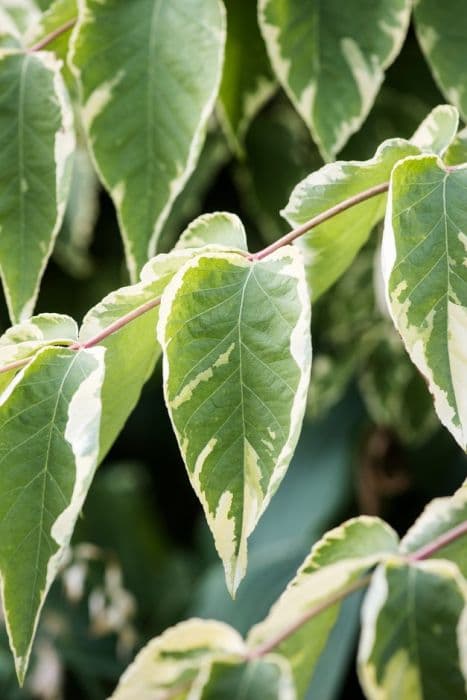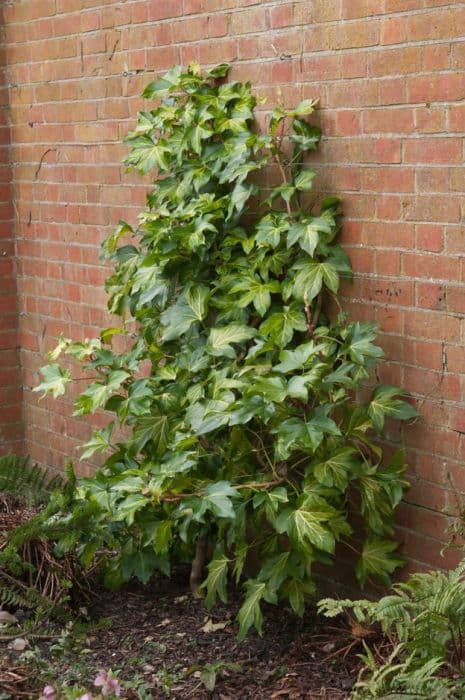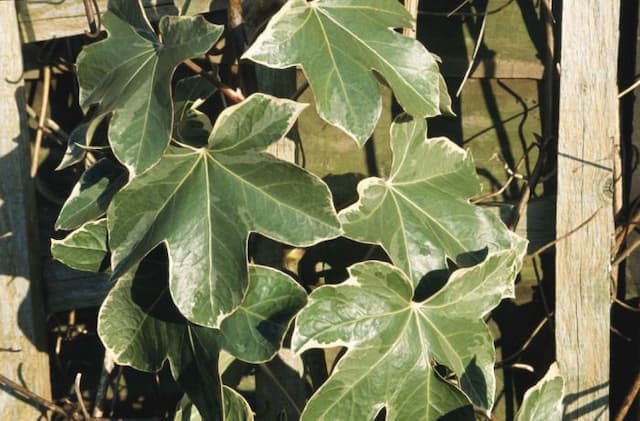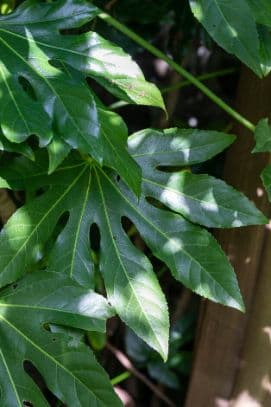Ivy 'Manda's Crested' Hedera helix 'Manda's Crested'

ABOUT
'Manda's Crested' is an evergreen medium-sized climber, the broad, dark green leaves five-lobed with wavy margins. In winter the leaves become tinged with bronze
About this plant
 Names
NamesFamily
Araliaceae.
Synonyms
English Ivy, Common Ivy, European Ivy, Ivy.
Common names
Hedera helix 'Manda's Crested'.
 Characteristics
CharacteristicsLife cycle
Perennials
Foliage type
Evergreen
Color of leaves
Variegated
Height
6-9 inches (15-23 cm)
Spread
50-100 feet (15-30 meters)
Plant type
Climber
Hardiness zones
5-9
Native area
Europe
Benefits
 General Benefits
General Benefits- Ornamental Appeal: The plant has unique foliage with crested or ruffled edges which adds aesthetic value to gardens or indoor spaces.
- Low Maintenance: It is a hardy plant that requires minimal care, making it ideal for those with busy lifestyles or beginners.
- Versatility: It can be used in various landscaping designs, such as ground covers, climbing vines, or hanging baskets.
- Drought Tolerance: Once established, it can tolerate periods of drought, reducing the need for frequent watering.
- Fast Growth: The plant grows quickly, providing rapid coverage for trellises, walls, and fences.
- Shade Tolerance: It can grow in shady spots where other plants might struggle.
- Erosion Control: When used as ground cover, it helps in preventing soil erosion on slopes and banks.
- Year-Round Interest: The plant maintains its foliage throughout the seasons, offering greenery even in winter months.
 Medical Properties
Medical PropertiesThis plant is not used for medical purposes.
 Air-purifying Qualities
Air-purifying QualitiesThis plant is not specifically known for air purifying qualities.
 Other Uses
Other Uses- Topiary Art: English ivy can be trained to grow over wireframes to create intricate topiary shapes in gardens or containers.
- Fabric Dyeing: The leaves of English ivy can be used to produce a range of natural dyes for fabrics, presenting hues from yellow to dark grey.
- Erosion Control: The robust nature and rapid growth of English ivy can help stabilize soil in areas prone to erosion.
- Backdrop for Photo Shoots: The picturesque quality of English ivy, with its dense foliage and cascading habit, makes it a popular backdrop for wedding and fashion photography.
- Privacy Screens: English ivy can be grown against walls or fences to create a lush, green privacy screen.
- Sound Insulation: The dense growth of English ivy can help muffle noises, making it a practical plant for urban areas to reduce sound pollution.
- Living Curtains: By training English ivy across a series of wires or strings, you can create a living curtain for a shaded, green space outdoors.
- Green Roofing: Hardy varieties of English ivy can be utilized in green roofing projects to cover rooftops with vegetation and improve building insulation.
- Garden Mazes: English ivy can be used to outline paths in garden mazes due to its dense growth and ease of shaping.
- Seasonal Decorations: During the holiday season, English ivy can be fashioned into natural wreaths or garlands to adorn homes and public spaces.
Interesting Facts
 Feng Shui
Feng ShuiThe English Ivy is not used in Feng Shui practice
 Zodiac Sign Compitability
Zodiac Sign CompitabilityThe English Ivy is not used in astrology practice
 Plant Symbolism
Plant Symbolism- Friendship: English Ivy, including Hedera helix 'Manda's Crested', is often associated with friendship due to its ability to cling and grow in close association with its support, symbolizing the intertwined nature of close relationships.
- Fidelity: The evergreen nature of English Ivy signifies lasting affection and fidelity in relationships, as it remains green throughout the year.
- Protection: This plant has been used traditionally to ward off evil spirits and it's thought to offer protection to the house it grows on, representing safety and security.
- Perseverance and Determination: The robust, vigorous growth and the plant's ability to thrive in challenging conditions symbolize an individual's ability to overcome obstacles.
- Eternal Life: Since English Ivy is evergreen, it is often used in religious contexts as a symbol of resurrection and immortality.
 Water
WaterThe English Ivy 'Manda's Crested' should be watered thoroughly until excess water drains out the bottom, then allow the top inch of soil to dry out before watering again. Generally, this might mean watering once every 1 to 2 weeks, but this can vary depending on environmental conditions. Avoid overwatering as this can lead to root rot. During the growing season, you might find the need to water more frequently, especially if it's in a warmer environment. It is best to use room temperature water and provide about half a gallon for a medium-sized pot at each watering, adjusting the amount based on the size of the plant and pot.
 Light
LightEnglish Ivy 'Manda's Crested' thrives in bright, indirect light but can also tolerate low light conditions. It should not be placed in direct sunlight as this can scorch the leaves. A spot near a north or east-facing window would be ideal, providing enough light without the harsh intensity of direct afternoon sun.
 Temperature
TemperatureEnglish Ivy 'Manda's Crested' prefers a consistent temperature range between 50 to 70 degrees Fahrenheit and can handle brief periods of temperatures as low as 10 degrees Fahrenheit. However, the ideal temperature for this plant is within the range of 60 to 70 degrees Fahrenheit for optimal growth and health.
 Pruning
PruningPrune English Ivy 'Manda's Crested' to control its growth, remove dead or damaged foliage, and encourage a fuller, bushier appearance. The best time for pruning is in the spring or early summer. Pruning can be done every few months as needed to maintain the desired shape and size.
 Cleaning
CleaningAs needed
 Soil
SoilEnglish Ivy 'Manda's Crested' thrives best in a well-draining, loamy soil mix with a pH between 6.0 and 7.5. A good recipe would be to mix two parts peat or coir, one part perlite or sand, and one part garden soil or compost. This blend ensures adequate drainage while maintaining some moisture and providing essential nutrients.
 Repotting
RepottingEnglish Ivy 'Manda's Crested' should generally be repotted every two to three years to avoid becoming root-bound and to replenish its soil. Young, actively growing plants may benefit from annual repotting, while older, more established plants can go longer between repottings.
 Humidity & Misting
Humidity & MistingEnglish Ivy 'Manda's Crested' prefers moderate to high humidity levels, ideally between 40% and 70%. Maintaining adequate humidity is especially important in dry indoor environments and can be achieved through regular misting or the use of a humidifier.
 Suitable locations
Suitable locationsIndoor
Place in medium light, ensure good drainage, and mist frequently.
Outdoor
Plant in partial shade, shelter from harsh winds, and water deeply.
Hardiness zone
5-11 USDA
 Life cycle
Life cycleEnglish Ivy 'Manda's Crested' begins its life cycle as a seed, which germinates in moist, shaded soil to create a small seedling. The seedling grows into a juvenile vine stage, characterized by its lobed leaves and vigorous climbing or spreading habit which is crucial for finding light and space. As it matures, the plant enters the adult phase, where the leaves become unlobed, and it develops the ability to flower and produce berries in the late summer to fall, which are then dispersed by birds. Following pollination, the flowers produce seeds completing the reproductive cycle. In its climbing stage, English Ivy uses aerial roots to attach to surfaces, while in its mature phase may grow more bush-like if there is no support to climb on. Over its lifespan, which can be several decades, the ivy will continue this cycle, spreading both vegetatively through runners and clonally through new shoots, as well as through seed dispersal by birds.
 Propogation
PropogationPropogation time
Spring-Early Summer
Propogation: The most popular method of propagation for English Ivy, specifically the Hedera helix 'Manda's Crested', is through stem cuttings. This process is best done in the spring or early summer when the plant is actively growing. Cut a 4 to 6-inch length of stem with several leaves attached using a clean, sharp knife or scissors. Remove the leaves from the lower half of the cutting to expose the nodes, where roots will sprout. The cutting can then be placed in water or a moist soil-less potting mix. If rooting in water, change the water every few days to keep it fresh. Once roots have formed, which can take several weeks, the new plant can be transferred to potting soil and cared for as a typical English Ivy plant.









